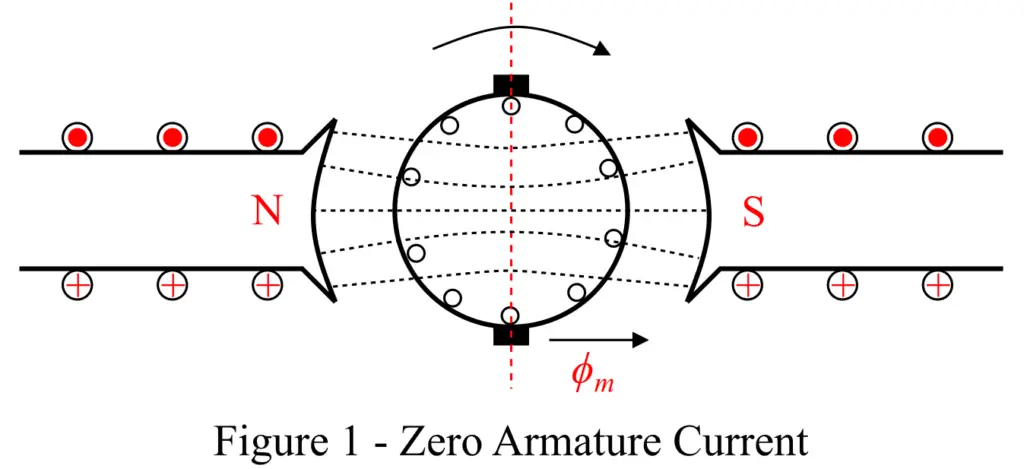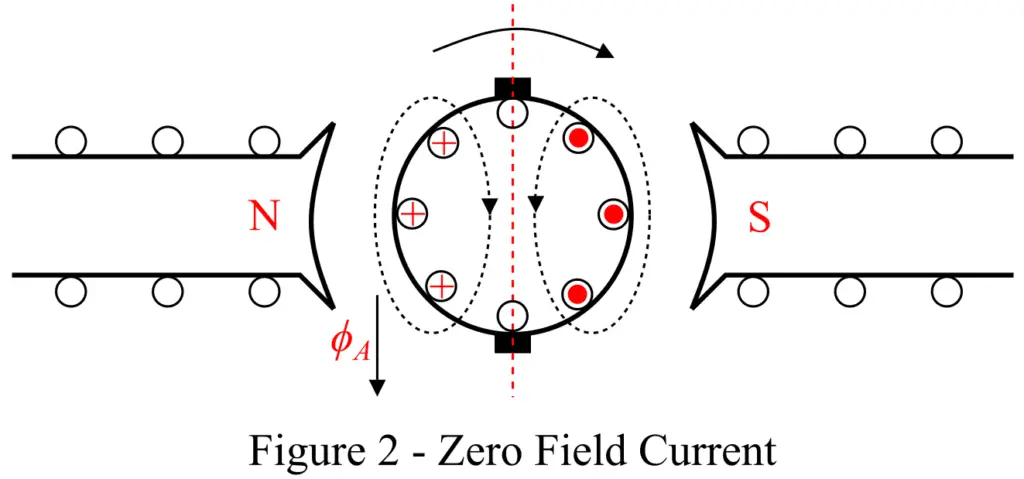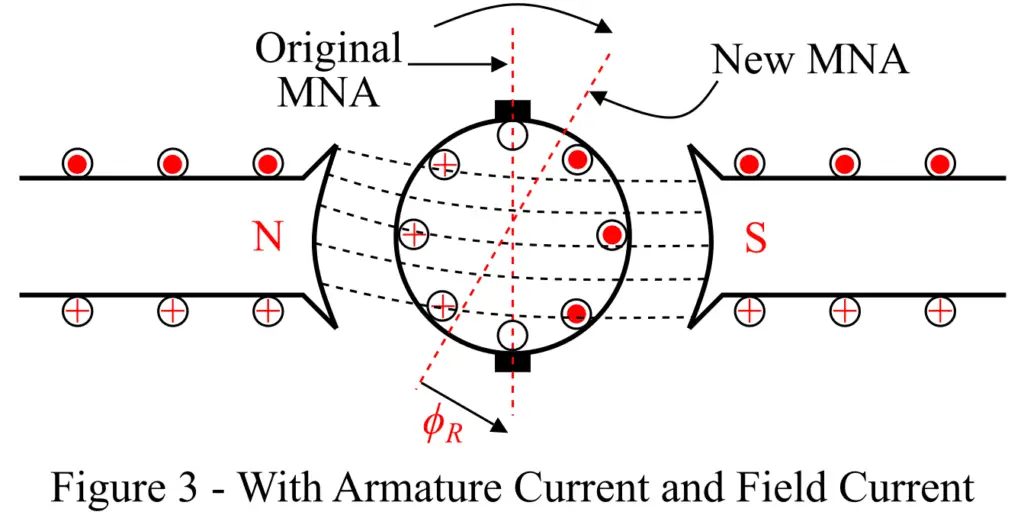In this article, we shall learn about the armature reaction in a DC generator, its effects, and the methods of minimizing it.
In a DC electric generator, there are two types of magnetic flux exist – main field flux and armature flux. The main flux is desirable because it is entirely responsible for the generation of voltage, i.e. working of the generator. Whereas the armature flux is undesirable, it is produced because of the current flowing in the armature winding.
The armature flux affects the main field flux, and this effect of the armature flux on the main field flux is known as armature reaction. In a DC generator, the armature reaction adversely affects the main flux, therefore it is undesirable. However, we cannot eliminate it completely, but we can reduce it.
The process and effects of the armature reaction in DC generators are described in the following sections.
Case I – When armature current is zero, i.e. no-load condition:

Consider a DC generator having two magnetic poles and operating on no-load. Under the no-load conditions, there is no electric current flowing through the armature winding. Thus, in this case, there is only a main field flux (ϕm) in the generator produced by the magnetic field system of the machine. Since there is no armature flux, hence the main flux is distributed symmetrically with respect to the polar axis as shown in the figure-1. Also, in this case, the magnetic neutral axis (MNA) and geometrical neutral axis (GNA) coincide with each other.
Case II – When armature winding carrying current with no current in field coils:

When the armature winding carries a current with no current in the field winding. In this case, the magnetic flux produced in the machine due to armature current only is called the armature flux (ϕA), as shown in figure-2.
We can determine the direction of the armature flux by the cork-screw rule. Here, we can see that the armature conductors under the N-pole carry a current directed into the plane of the paper, hence the magnetic flux due to these conductors is in the downward direction.
The conductors under the S-pole carry current directed outward of the plane of the paper. Hence, the armature flux due to these conductors is also in the downward direction. Thus, we can observe that all the armature flux is in the downward direction.
Case III – When the Field Flux and Armature Flux are acting simultaneously:
The two fluxes exist inside the generator when both armature winding and field winding carry electric currents simultaneously. One flux is due to current through main field winding and another is due to current through armature winding. The combination of these two fluxes gives a resultant flux (ϕR) in the machine.

Here, the armature flux shifts and destroys the main field flux entering the armature. The field flux in the north-pole’s upper pole-tip and the south-pole’s lower pole-tip increase because of distortion in the main field flux. In the same way, the flux density in the lower pole-tip of the north pole and in the upper pole-tip of the south-pole decrease.
Therefore, the direction of the resultant magnetic flux shifts in the direction of the rotation of the armature. Since we know that the MNA must always be perpendicular to the axis of the resultant flux. Therefore, the MNA is also get shifted. This non-linear behavior and saturation of the resultant flux cause a decrease in the main field flux in the machine. As a result, the generated voltage decreases with an increase in load.
Adverse Effects of Armature Reaction in DC Generator
The following are some major effects that the armature reaction causes in a DC generator.
- The total magnetic flux created by each pole is reduced, which in turn reduces the induced emf in the generator.
- The MNA (magnetic neutral axis) is shifted in the direction of rotation of the armature, this shifting of MNA is due to shifting in the axis of resultant flux.
- The armature reaction causes a magnetic flux in the neutral zone. This flux in the neutral zone induces a voltage in the armature windings which causes commutation problems.
Remedies of Armature Reaction in DC Generator
In practice, we use the following four methods to minimize the effects of the armature reaction in a DC generator.
Brush position adjustment
We can reduce the effect of armature reaction by adjusting the positions of brushes. In this method, the carbon brush assembly is rotated to find the correct position of the neutral zone. However, this method can only be applied to the fixed load current.
Modification of ends of magnetic poles
In this method, we modify the pole tips of magnetic field poles to have high reluctance, this controls the flux density to become high at the ends of poles.
Interpoles
We can also reduce the effect of armature reaction by using a set of interpoles between the main field poles of a DC generator. In the case of a DC generator, the polarity of the interpole is the same as that of the main field pole just next to it in the direction of armature rotation.
The windings of the interpoles are connected in series with the armature so that the interpole flux changes with the change in load current, and hence compensate for the effect of armature reaction.
Compensating Winding
The DC generators subjected to heavy-duty operations have sudden changes in the armature reaction. Therefore, in these generators, the interpoles are not able to neutralize the effects of the armature reaction. In such generators, we use compensating windings to minimize the armature reaction effects.
The compensating windings are auxiliary windings placed on the main field poles and are connected in series with the armature winding. The direction of the current in compensating windings is such that it will be opposite to the current through the adjacent armature conductor. In this way, the compensating windings produce a magnetic flux that is equal to and opposite to the armature flux and hence helps in reducing the effects of the armature reaction.